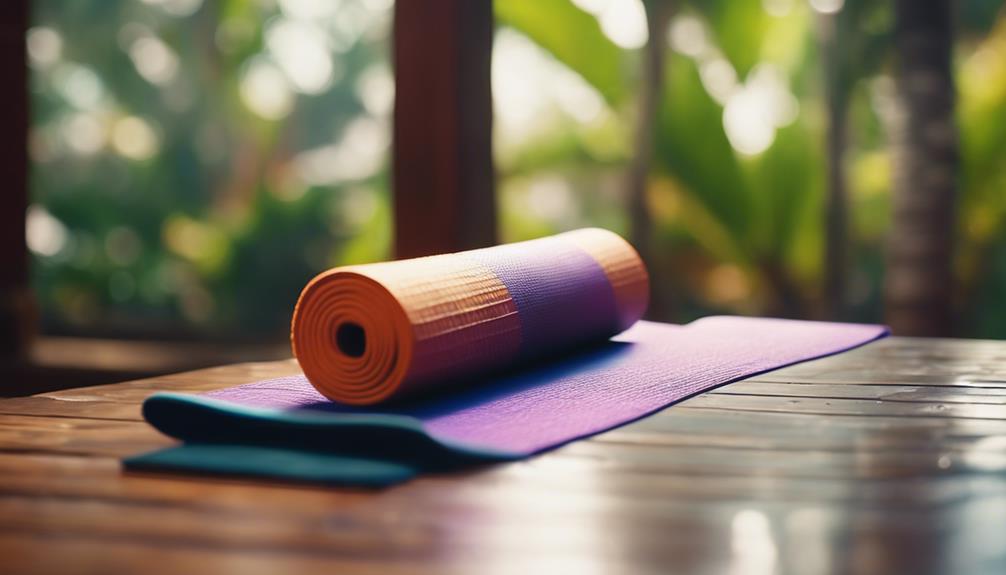How Much Is Yoga Training Bali?
In a world where the cost of a loaf of bread isn't 10 cents anymore, you're probably wondering what the price tag on a yoga training course in Bali might be.
It's not just the training you're paying for, there are other factors at play as well – accommodation, food, the season, and even the specific location in Bali.
You might think it's a straightforward question, but hold your horses. Just like a yoga pose, it's more complex than it looks on the surface.
So, shall we begin to unfold this intriguing topic?
Key Takeaways
- Bali yoga training costs vary based on season, location, and accommodation type.
- Different yoga styles and programs in Bali have unique cost structures.
- Additional costs include food, transport, personal expenses, and visa fees.
- Payments for Bali yoga training are typically made online through secure methods.
Understanding Yoga Training Costs

Let's dive right into unraveling the costs associated with yoga training, as getting a clear grasp on this can help you budget effectively and plan your journey in Bali. A detailed Hidden Costs Analysis won't only reveal the surface-level fees for the training sessions but also the often-overlooked expenses such as accommodation, meals, and travel.
First, consider the fees for the yoga training itself. These can range drastically, based on the yoga school's reputation, the program's duration, and the expertise of the instructors. Don't be lured by the cheapest option; remember, quality shouldn't be compromised for cost.
Next, account for the living expenses. Bali is affordable, but costs can still mount up. Analyze the costs of accommodation, meals, local travel, and any extra activities you might want to indulge in.
Types of Yoga Training Programs
You'll discover a variety of yoga training styles in Bali, each with its own unique cost structure and schedule.
Whether you're a beginner or a seasoned yogi, there's a program that's right for you.
We'll now explore these different programs, their costs, and the time commitment each one requires.
Different Yoga Training Styles
In discussing yoga training programs in Bali, examining the various styles available, each offering unique benefits and challenges, is important. The styles range from traditional forms that foster yoga philosophy exploration to more modern approaches focusing on health benefits analysis.
Here's a look at three popular styles:
- Hatha Yoga: This traditional form emphasizes physical postures and breathing techniques. It's an excellent starting point for beginners.
- Ashtanga Yoga: A more demanding style, it requires consistent practice and dedication. It's ideal if you're looking to challenge your limits and deepen your yoga philosophy understanding.
- Yin Yoga: A slow-paced style where poses are held for longer periods, Yin Yoga is perfect for those seeking stress relief and flexibility improvement.
Choose the style aligning with your goals and preferences.
Cost of Training Programs
After selecting a style that suits your yoga goals, the next step is figuring out how much you're going to invest in your training program. It's important to contemplate both the training benefits and the associated costs. Different programs offer diverse levels of instruction, resources, and experiential learning, all of which contribute to the overall value.
Don't let the cost deter you from pursuing your passion. Many schools offer financing options, making it more accessible for you to set out on this transformative journey. Some even provide early bird discounts or payment plans. Remember, your investment goes beyond the monetary; it includes the invaluable skills and personal growth you'll gain. Choose wisely and invest in a program that aligns with your goals and budget.
Duration and Schedules
Choosing the right yoga training program also involves considering the duration and schedule that best fits your lifestyle. Training intensity and instructor expertise matter, but if you can't accommodate the hours, you'll struggle to complete the course.
Here are some factors to consider:
- Training Intensity: Some programs offer intensive, full-time training that might require a significant time commitment. Others have a more relaxed pace, allowing you to balance your training with other responsibilities.
- Instructor Expertise: Quality training depends on the expertise of the instructor. Make sure they've the experience and qualifications to guide you through your yoga journey.
- Flexibility: Does the schedule align with your daily routine? If not, look for programs that offer weekend or evening classes, or even online modules.
Duration of Yoga Training Courses
You'll find that yoga training courses in Bali vary greatly in length, offering both extensive training options and short-term programs.
From immersive months-long journeys to compact week-long intensives, there's a course to suit your schedule.
It's important to contemplate your time commitment and objectives when choosing which course duration is right for you.
Course Length Variations
Depending on your availability and commitment, the duration of yoga training courses in Bali can range from intensive two-week programs to more thorough 200-hour courses spread over a month. This course flexibility allows you to find the right pace and intensity to suit your personal needs.
The quality of instructors also plays a significant role in the course length variations. Highly skilled teachers can condense detailed knowledge into shorter timeframes, ensuring you still receive an in-depth understanding of yoga principles.
- Some courses offer a quick immersion into yoga, ideal for those with limited time.
- Others provide a more gradual learning curve, perfect for individuals looking for a deeper understanding.
- There are also courses that span over a few months for those inclined towards mastering the discipline.
Extensive Training Timeframes
In the domain of yoga training, opting for extensive courses that span over several months can truly deepen your understanding and mastery of this ancient practice. With an increased training intensity, these longer courses allow you to explore the intricacies of yoga, from diverse asanas to profound philosophies.
Not only do you gain a thorough knowledge base, but you also have the chance to experience personalized coaching. This one-on-one attention enhances your learning experience, enabling you to refine your technique and understanding, thereby cultivating a stronger mind-body connection.
The extended timeline also fosters your growth, as the slow and steady approach ingrains the principles of yoga into your daily life. So, consider these lengthier programs to truly immerse yourself in the practice.
Short-term Training Options
While long-term training programs offer in-depth understanding and mastery, short-term yoga training courses in Bali can provide a more condensed, yet equally enriching experience. You'll find that these brief courses pack a punch regarding training intensity and equipment needs, without sacrificing the spiritual and physical growth that yoga offers.
- High-intensity training: These programs often have a higher daily training intensity, immersing you in yoga practice and theory in a shorter timeframe.
- Essential equipment: Short-term courses tend to focus on fundamental yoga postures, reducing your equipment needs to the basics.
- Flexible schedules: Many offer flexible schedules, accommodating those who may not have the luxury of extended periods away from work or other commitments.
Embrace the challenge and reap the rewards of short-term yoga training in Bali.
Seasonal Pricing Variations
You'll notice that the cost of yoga training in Bali can fluctuate greatly throughout the year due to seasonal pricing variations. This is because most Bali yoga training centers adjust their rates to reflect the demand. When there are fewer tourists, you'll find more discount opportunities. This typically happens during the off-peak season, which is also when you'll enjoy more tranquility and personalized attention from instructors.
Off-peak benefits go beyond just cost savings. The quieter environment can greatly enhance your yoga practice and overall experience. Not to mention, you'll have more opportunities to explore Bali's natural beauty without the tourist crowds.
To give you a clearer picture, here's a breakdown of the typical pricing variations:
| Season | Pricing Adjustment |
|---|---|
| Peak (July-August, December-January) | Higher due to high demand |
| Shoulder (April-June, September-October) | Moderate, with some discounts available |
| Off-Peak (February-March, November) | Lowest, with the most discount opportunities |
Location and Accommodation Costs

Another significant factor that can affect your yoga training cost in Bali is the location and accommodation you choose. The island offers diverse options, from budget-friendly hostels to luxurious villas, with each offering a unique experience that contributes to your overall Bali travel expenses.
Consider these factors as you decide where to stay:
- Proximity to the training center: Staying closer can save you commuting time and transportation costs.
- Type of accommodation: Luxury resorts undoubtedly offer more amenities but also come with a higher price tag. Budget accommodations can be a more economical choice if you're not after extravagance.
- Cultural immersion costs: If you're looking forward to immersing yourself in the local culture, consider accommodations near culturally-rich areas. These might carry additional costs but can greatly enrich your experience.
Additional Expenses to Consider
Beyond accommodation and location, there are other expenses you should factor into your budget when planning for yoga training in Bali. One important consideration is Travel Insurance. While it's easy to overlook, it's an essential safeguard against unforeseen circumstances. It covers anything from medical emergencies to trip cancellations. You wouldn't want a sprained ankle or a volcano eruption to wipe out your savings, would you?
Another additional expense comes in the form of Visa Costs. Depending on where you're coming from, you may need to apply for a visa. The price can vary, so it's worth researching ahead of time. Be aware that overstaying your visa in Bali has hefty fines, so plan your stay carefully.
You'll also need to budget for food, transport, and personal expenses. Local meals can be quite affordable, but if you prefer organic or specialized diets, costs can add up. Transports like scooter rentals or taxis are also common costs, and don't forget about personal necessities like toiletries or souvenirs.
While these costs may seem challenging, remember that investing in your well-being is invaluable. With careful planning, your yoga training in Bali can be a transformative, affordable experience.
Payment and Booking Methods

Having considered these additional expenses, it's time to turn our attention to the process of payment and booking for your yoga training in Bali. In this digital era, many yoga centers in Bali have streamlined the payment and booking process, making it more convenient and secure for you.
Most yoga centers in Bali facilitate online transactions. This means you can pay for your yoga training from the comfort of your home, without worrying about currency exchange rates. It's important, however, to make sure that the website you're using offers payment security. This guarantees that your sensitive financial information remains confidential and safe from potential breaches.
To give you a clearer picture, here are some common methods of payment and booking:
- Credit or Debit Card Payments: This is the most common method of payment. It's quick, secure, and often comes with extra benefits like cash back or points.
- Bank Transfers: Some centers offer the option to pay directly from your bank account. Make sure to verify the account details before making a transfer.
- Payment Apps: Some yoga centers allow payments through popular mobile payment apps.
Remember to keep your payment confirmations safe. They're your proof of payment and can help resolve any payment-related issues that may arise.
Budgeting Tips for Yoga Training
Now, let's explore some practical tips to assist you in budgeting effectively for your yoga training in Bali. Financial planning is important to make sure you can comfortably afford this transformative experience.
Begin by researching thoroughly on various training packages and their inclusions. Identify the ones that align best with your yoga aspirations and financial capacity.
Next, consider savings strategies. Start setting aside a certain amount weekly or monthly specifically for your yoga training. This could be from your salary, bonuses, or even from cutting back on non-essential expenditures. It's surprising how quickly these savings can accumulate over a few months.
In addition, look for flexible payment options. Some yoga centers offer installment plans that can ease the financial burden. Also, early bird discounts are quite common in the yoga industry, so it's worth booking your training well in advance.
Benefits of Investing in Yoga Training

Investing in yoga training, particularly in a serene location like Bali, can yield a wealth of benefits for your physical, mental, and spiritual health. The holistic approach of yoga integrates body, mind, and soul, and can be transformative in your quest for health benefits and mental wellness.
Yoga training offers the following advantages:
- Enhanced Physical Fitness: Yoga improves strength, flexibility, and balance. It's a low-impact exercise that's gentle on your joints, making it suitable for all fitness levels.
- Mental Wellness Boost: Regular yoga practice reduces stress and anxiety. Through mindfulness and meditation, you'll cultivate a calm, focused mind.
- Spiritual Growth: Yoga is more than just physical exercise. It's a spiritual discipline that promotes self-awareness and inner peace.



